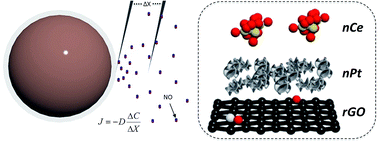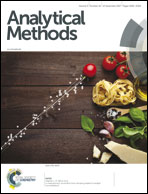Microprofiling real time nitric oxide flux for field studies using a stratified nanohybrid carbon–metal electrode†
Abstract
Nitric oxide (NO) is an important signaling molecule that is involved in stress response, homeostasis, host defense, and cell development. In most cells, NO levels are in the femtomolar to micromolar range, with extracellular concentrations being much lower. Thus, real time measurement of spatiotemporal NO dynamics near the surface of living cells/tissues is a major challenge. Here, we report the development, application, and validation of a self referencing (i.e., oscillating) NO microelectrode for field studies of biological cells and tissues. The durable microelectrode is based on a hybrid nanomaterial composed of nanoceria, reduced graphene oxide and nanoplatinum and is intended for field use. One of the main focuses was to address the common pitfall of high overpotential through use of hydrophobic, and size/charge-selective materials in a thin film coated on top of the nanocatalyst sensor. The sensitivity (0.95 ± 0.03 pA nM−1), response time (1.1 ± 0.1 s), operating potential (+720 mV), and selectivity of the nanomaterial-modified microelectrode are similar to laboratory microelectrode designs, enabling studies of NO flux in field studies. NO efflux was first measured from chitosan and alginate polymers in abiotic studies, and a deterministic model used to determine the effective diffusion coefficient for each polymer composite. To demonstrate the practicality of the sensor, NO flux was quantified in three model organisms with known NO pathways, including: bacteria, plant, and an invertebrate animal. For each organism, an established hypothesis was validated based on NO flux measurement and the results confirm data collected using standard analytical techniques. The sensor can be used to expand our fundamental knowledge of NO transport by facilitating field experiments which are not possible with standard techniques.



 Please wait while we load your content...
Please wait while we load your content...